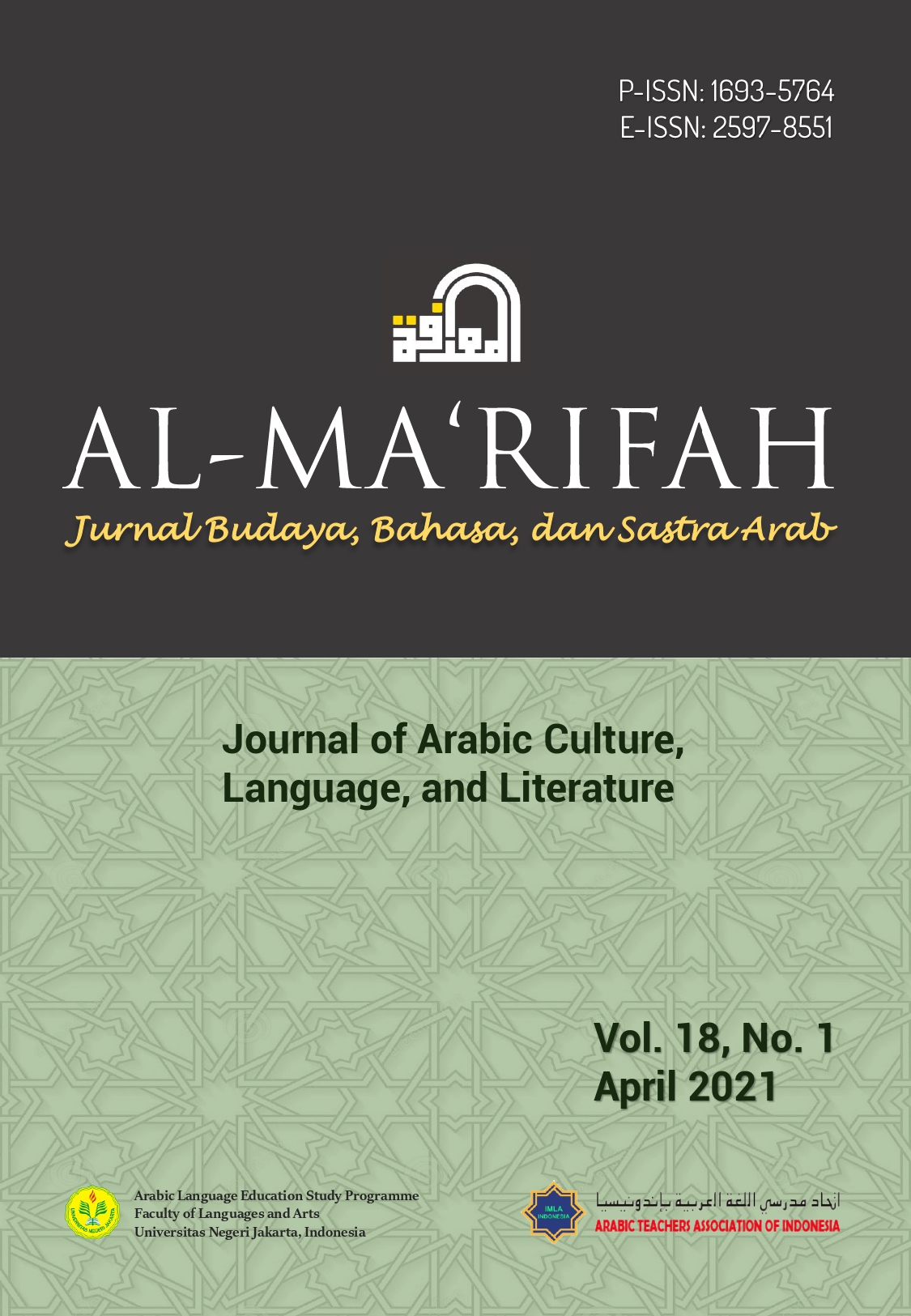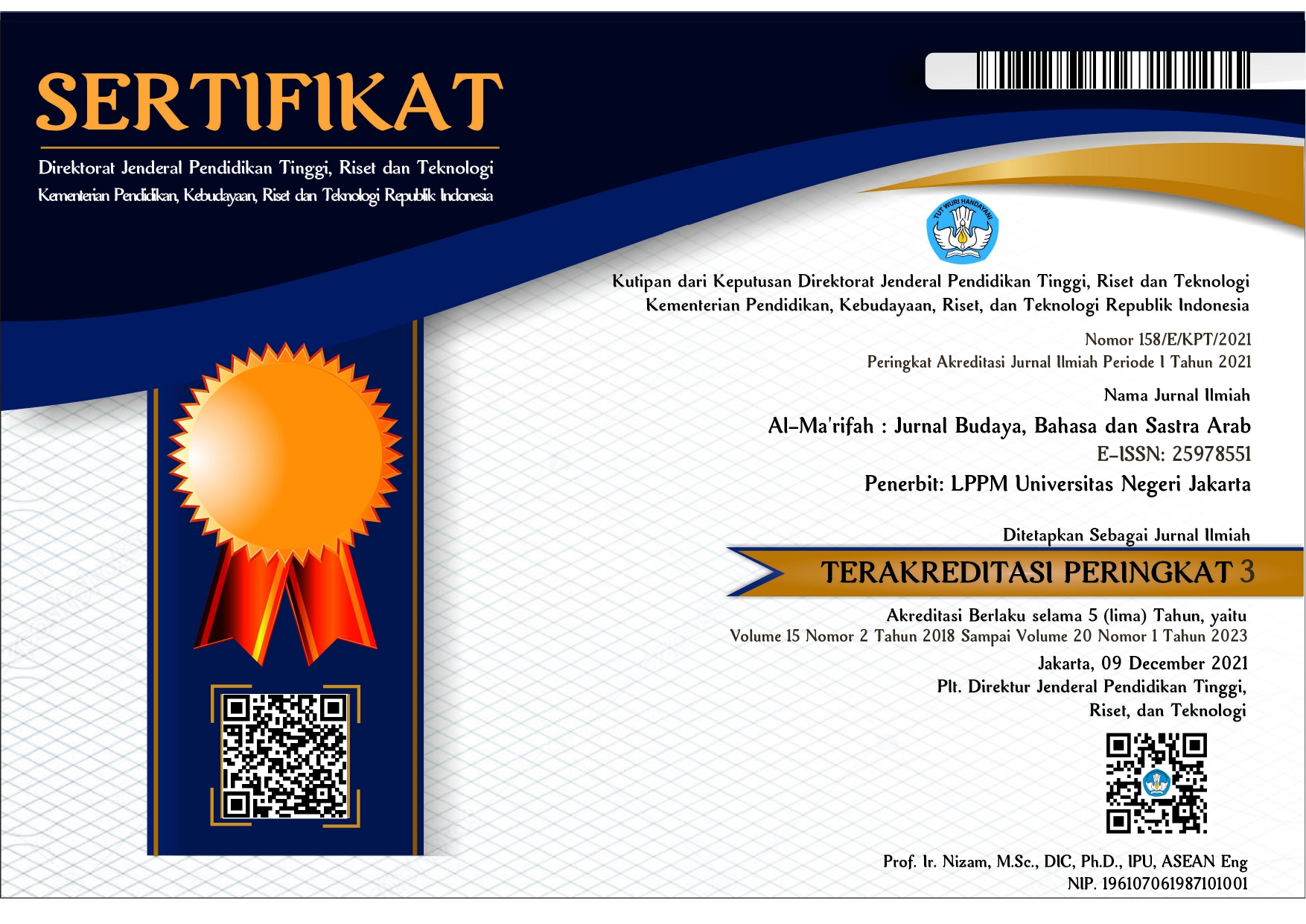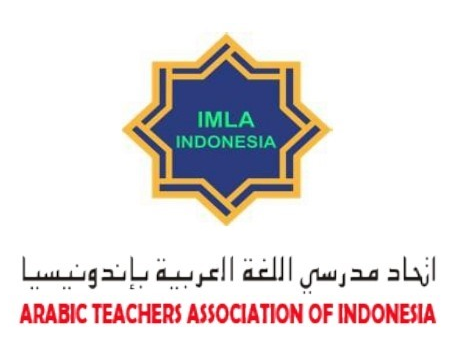Intertekstualitas dalam Puisi Arab: Puisi al-Ḥallāj dan Fārūq Juwaydah
Abstract
This study aims to reveal the intertextual found between al-Ḥallāj’s poem (qaṣīdah) and Faruq Juwaidah’s wa Tāba al-Qalb poem. In this case, it refers to the basic assumption of intertext studies, namely that the texts or works that appear today are inseparable from the influence and role of the works that previously existed long before. Furthermore, in intertextual studies, old works that are used as a reference in making new works are called hypograms, while new works written by new authors that appear later are called transformational works. The method in this research is using descriptive analysis method. While the approach used is intertextual. Based on the results of the intertextual analysis conducted by researcher on qaṣīdah al-Ḥallāj and wa-Tāba al-Qalb poem, the researchers found (1) wa-Tāba al-Qalb poem is a form of transformation of qaṣīdah al-Ḥallāj, (2) wa-Tāba al-Qalb poem is the response from qaṣīdah al-Ḥallāj. The results of this study indicate that the impact or influence of old literary works on those that emerged later was very strong.
References
Abdullah, A-S. (2009). Intertextuality and West African Arabic poetry: Reading Nigerian Arabic poetry of the 19th and 20th Centuries. Journal of Arabic Literature, 40(3), 335–361. Retrieved from http://www.jstor.org/stable/20720593
Ahmed, M. A., Hasan, R. A., Ali, A. H., & Mohammed, M. A. (2019). The classification of the modern Arabic poetry using machine learning. Telkomnika, 17(5), 2667–2674. doi:10.12928/telkomnika.v17i5.12646
Albay, M., & Serbes, M. (2017). Intertextuality in the literature. International Journal of Social Sciences and Educational Studies, 3(4), 208–214. doi:10.23918/ijsses.v3i4p208
Al Hinduan, N., Tohe, A., & Huda, I. S (2020). Karakteristik dan fungsi puisi Arab pada Masa transisi pemerintahan Dinasti Umayyah ke Dinasti Abbasiyah. Alsina: Journal of Arabic Studies, 2(1), 51–70. doi:10.21580/alsina.2.1.5127
Ansari, N. (2016). Shi‘r Fārūq Juwaydah: Dirāsah uslūbīyah fī shi‘rih al-multazam. Majallat al-Lughah al-‘Arabīyah wa-Ādābihā ‘Ilmīyah Muḥakkamah, 12(1), 27–47. Retrieved from https://www.sid.ir/fa/journal/ViewPaper.aspx?id=320638
Ansari, M. A. H. (2000). Ḥusayn ibn Manṣūr al-Ḥallāj: Ideas of ecstatic. Islamic Studies, 39(2), 291–320. Retrieved from https://www.jstor.org/stable/23076104
al-‘Aṭawī, M. I. (2016). al-Adab al-‘Arabī al-ḥadīth. n.p.: Shabakah al-Alūkah.
Bagir, H. (2019a). Mengenal tasawuf. Jakarta: Noura Books.
Bagir, H. (2019b). Semesta cinta: Pengantar kepada pemikiran Ibn ‘Arabi. Jakarta: Noura Books.
Batmang. (2019). Ekspresi Amir Hamzah dan Chairil Anwar dalam puisi-puisi percintaan. Kandai, 15(2), 185–200. doi:10.26499/jk.v15i2.939
El Shirazy, H. (2014). Berdakwah dengan puisi: Kajian intertekstual puisi-puisi religius Taufiq Ismail. At-Tabsyir: Jurnal Komunikasi Penyiaran Islam, 2(1), 35–56. doi:10.21043/at-tabsyir.v2i1.462
Endraswara, S. (2011). Metodologi penelitian sastra: Epistemologi, model, teori dan aplikasi. Yogyakarta: CAPS.
Faruq. (2014). Metode penelitian sastra: Sebuah penjelajahan awal. Yogyakarta: Pustaka Pelajar.
Feener, R. M. (1998). A re-examination of the place of al-Ḥallāj in the development of Southeast Asian Islam. Bijdragen tot de taal-, Land- en Volkenkunde /Journal Of Humanities and Social Sciences of Southeast Asia and Oceania, 154(4), 571–592. doi:10.1163/22134379-90003885
Hadi A. W. M. (1999). Kembali ke akar kembali ke sumber: Esai-esai sastra profetik dan sufistik. Jakarta: Pustaka Firdaus.
Haidar, A. (1981). What is modern about modern Arabic poetry? Al-‘Arabiyya, 14(1), 51–58. Retrieved from https://www.jstor.org/stable/43195490
Hamkah, Z. (2018). Husain Al-Hallaj dan ajarannya. Ash-Shahabah, Jurnal Pendidikan Studi Islam, 4(2), 183–188. Retrieved from https://journal-uim-makassar.ac.id/index.php/ASH/article/view/226
Jabrohim (ed). 2017. Teori penelitian sastra. Yogyakarta: Pustaka Pelajar.
Juwaydah, F. (1991). al-Majmūah al-kāmilah. Cairo: Markaz al-Ahrām li-al-Tarjamah wa-al-Nashr.
Kamil, S. (2009). Teori kritik sastra Arab klasik dan modern. Jakarta: Rajawali Pers.
Khezri, A., & Hamdi, M. (2020). Tajalliyāt al-nustūlūjīyah wa-ẓawāhiruhā fī shi‘r Fārūq Juwaydah. Majallat al-‘Ulūm al-Ijtimā‘īyah wa-al-Insānīyah, 13(2), 137–153. Retrieved from https://www.asjp.cerist.dz/en/article/141922
Kuntiwijoyo. (2019). Maklumat sastra profetik. Yogyakarta: Diva Press.
Madās, A. (2004). Taḥlīl al-khiṭāb al-shi‘r fī manẓūr al-lisānīyāt al-naṣṣīyah: Dirāsah taṭbīqīyah li-qaṣīdatay al-Masā’ li-Īliyā Abū Māḍī wa-Qāri’at al-Finjān li-Nizār al-Qabbānī (Master’s thesis, Université Mohamed Khider Biskra, Algeria). Retrieved from http://thesis.univ-biskra.dz/2177/
Makārim, S. (2016). al-Ḥallāj fī mā warā’a al-ma‘ná wa-al-khaṭṭ wa-al-lawn. London: Riad El-Rayyes Books.
Miswari. (2019). Cara gila jatuh cinta: Analisa qasidah dan muqataat Mansur Al-Hallaj. Al-Mabhats: Jurnal Penelitian Sosiologi Agama, 4(1), 51–74. Retrieved from https://ejurnal.iainlhokseumawe.ac.id/index.php/al-mabhats/article/view/284
Mousa, M. A. (2013). Literary intertextuality and its Meaning in the Arabic modern criticism. Research Journal of International Studies, 26, 142–147.
Mukarromah, O. (2015). Ittihad, hulul, dan wahdatul wujud. Tazkiya: Jurnal Keislaman, Kemasyarakatan, dan Kebudayaan, 16(1), 129–146. Retrieved from http://jurnal.uinbanten.ac.id/index.php/tazkiya/article/view/212/214
Musa, I. A. (2019). Arabic literature in Abbasid Period. Abuja: National Open University of Nigeria.
Muzakka, M. (2018). Hubungan intertekstualitas syair Paras Nabi dan hikayat Nabi Bercukur. Nusa: Jurnal Ilmu Bahasa dan Sastra, 13(3), 341–350. doi:10.14710/nusa.13.3.341-350
Naemi, Z. & Zaemohammedi, S. (2014). Tajalliyāt al-Muqāwamah al-Filisṭīnīyah fī Shi‘r Fārūq Juwaydah. Naqd Adab ‘Arabī, 5(1), 173–208. Retrieved from https://www.sid.ir/fa/journal/ViewPaper.aspx?id=322614
al-Ni‘āmī, M. M. (2012). Tajalliyāt al-tanāṣ fī dīwān Mukhtārāt min Shi‘r Intifāḍat al-Aqṣá, al-juzz al-awwal. Majallat al-Jāmi‘ah al-Islāmīyah li-al-Buḥūth al-Insānīyah, 20(2), 99–141. Retrieved from https://journals.iugaza.edu.ps/index.php/IUGJHR/article/view/716
Pradopo, R. D. (2019). Pengkajian puisi. Yogyakarta: Gadjah Mada University Press.
Ratih, R. (2017). Teori dan aplikasi semiotika Michaeil Riffaterre. Yogyakarta: Pustaka Pelajar.
Ratna, N. K. (2015). Teori, metode, dan teknik penelitian sastra. Yogyakarta: Pustaka Pelajar.
Roshanfar, K., & Rakhshadehnia, S. A. (2010). Qinā‘ al-Ḥallāj fī al-Shi‘r al-‘Arabī al-Mua‘ṣir: Ṣalāḥ ‘Abd al-Ṣabūr wa-‘Abd al-Wahhāb al-Bayātī Numūdhajān. Majallat ‘Ulūm Insānī, 17(3), 13–28. Retrieved from https://www.sid.ir/fa/journal/ViewPaper.aspx?ID=196773
Sholihah, A., & Kaulin, F. (2017). Hypatia dalam novel Azazil dan film Agora: Kajian sastra bandingan. Al-Ma‘rifah: Jurnal Budaya, Bahasa, dan Sastra Arab, 14(2), 102–113. doi:10.21009/almakrifah.14.02.07
Simuh. (2018). Sufisme Jawa: Transformasi tasawuf Islam ke mistik Jawa. Yogyakarta: Narasi & Promethea.
Syafi’i, K. (2003). Tafakur di ujung cinta. Yogyakarta: Pustaka Pelajar.
al-Shaybī, K. M. (Ed.). (1993). Sharḥ Dīwān al-Ḥallāj. Berlin: Manshūrāt al-Jamal.
al-Shaybī, K. M. (1998). al-Ṣilah bayna al-taṣawwuf wa-al-tashayyu‘. Cairo: Dār al-Ma‘ārif.
Taufiq. (2014). Al Hallaj sufi mati di tiang salib: Kajian filsafat bebas nilai. Pena: Jurnal Ilmu Pengetahuan dan Teknologi, 26(1), 23–34. Doi:10.31941/jurnalpena.v26i1.106
Tualeka, M. W. N. (2017). Kajian kritis tentang tasawuf al-Hallaj. Al-Hikmah: Jurnal Studi Agama-agama, 3(2). Retrieved from http://journal.um-surabaya.ac.id/index.php/Ah/article/view/1046
‘Uyūn al-Sūd, M. B. (Ed.). (2013). Dīwān al-Ḥallāj wa-ma‘ahu akhbār al-Ḥallāj wa-dhikr maqtal al-Ḥallāj li-Ibn Zanjī wa-kitȃb al-Ṭawāsīn. Beirut: Dār al-Kutub al-‘Ilmīyah.
Weidner, G. (2017). Popular literature in the Abbasid caliphate: How it represented and defined the culture of the Abbasid. University of Massachusetts Undergraduate History Journal, 1(2),19–32. doi:10.7275/R5CR5RH8
Copyright (c) 2021 Sammad Hasibuan

This work is licensed under a Creative Commons Attribution 4.0 International License.











